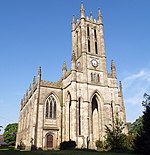Parish Church of St Mary, Radcliffe
Anglican Diocese of ManchesterChurch of England church buildings in Greater ManchesterGrade I listed churches in Greater ManchesterRadcliffe, Greater Manchester

The Parish Church of St Mary, Radcliffe is a church in Radcliffe, Greater Manchester. It was built during the 14th century, but the tower was not added until the 15th century. The building is designated Grade I by English Heritage, having been listed in 1966 under its former name of the Church of St Mary and St Bartholomew. In 1991, some local parishes were merged, and the church adopted its present name.The churchyard contains the war graves of six soldiers of World War I and three of World War II.
Excerpt from the Wikipedia article Parish Church of St Mary, Radcliffe (License: CC BY-SA 3.0, Authors, Images).Parish Church of St Mary, Radcliffe
Rectory Close,
Geographical coordinates (GPS) Address Nearby Places Show on map
Geographical coordinates (GPS)
| Latitude | Longitude |
|---|---|
| N 53.564428 ° | E -2.308084 ° |
Address
Rectory Close
M26 2PB , Irwell Bank
England, United Kingdom
Open on Google Maps






